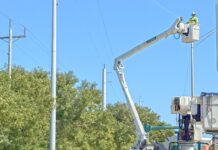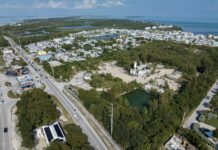
A tiny island that once served as a base camp for workers who built the historic Florida Keys Over-Sea Railroad has gone green.
On Friday, Keys officials celebrated the conversion of the island’s electrical system to solar-powered energy, making the educational facility and visitor attraction energy efficient.
A 105- by 11-foot solar array was installed by Keys-based Sea Air Land Technologies to satisfy nearly 95 percent of the electrical needs for the 5.3-acre islet beneath the middle of the old Seven Mile Bridge near Marathon.
For more than 100 years, electrical power on Pigeon Key was generated by steam or fossil fuels. But soaring fuel prices have taxed the Pigeon Key Foundation’s annual operating budget.
Now, two banks of 24-cell batteries that each generate 48 volts store electricity to feed 240-volt inverters that handle 90 to 95 percent of the island’s electrical needs.
“School kids come from all over the world and we teach them to be better environmental stewards and it’s nice to finally be able to start practicing what we preach,” said Kelly McKinnon, the foundation’s executive director. “Going green and having this solar energy as opposed to burning the fuel all the time.”
Listed on the National Register of Historic Places, Pigeon Key features restored cottages and a visitor’s museum that showcases the railroad’s fascinating history.
Officials believe that the near $225,000 solar investment will be paid back within five years for the island. The Monroe County Tourist Development Council funded about half of the project with the remaining financing provided by BB&T.

























